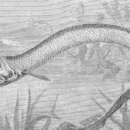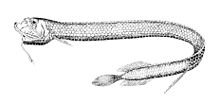ar
الأسماء في صفحات التنقل


Stomias boa is a common predator of meso- and bathypelagic oceanic waters. Two subpecies are recongnized: S. boa boa, known from the western Mediterranean, off West Africa and in the Southern Ocean, and S. boa ferox, known throughout much of the subtropical, tropical, and temperate Atlantic.. These taxa are distinguished by the number of photophores in the ventral row (see "Diagnostic Description").
View data on Catalog of Fishes here.
Barbel usually about as long as head, with 3 short filaments arising from end of distal bulb; upper jaw with a small anterior tooth, a large fang and 3 to 5 smaller teeth; lower jaw with 2 small anterior teeth, 2 large teeth and 3 to 7 smaller teeth. Six rows of hexagonal areas above lateral series of large photophores; 82–91 photophores in ventral series (IC, from anterior end of isthmus to fleshy part of tail). Color iridescent silver.
Temperate, subtropical, and tropical oceanic waters of the Atlantic; also in the Southerd Ocean and temperate latitudes of the Indian Ocean.
Deep oceanic waters to more than 1,000 m depth; may migrate to near-surface waters at night
Gibbs RH, Jr. 1984. Stomiidae. In: Whitehead PJP, Bauchot M-L, Hureau J-C, Nielsen J, Tortonese E, editors. Fishes of the North-eastern Atlantic and the Mediterranean. Paris: UNESCO. p 338–340.
Species of the genus Stomias are very elong and slender, with large jaws bearing fang-like teeth and a moderately long and posteriorly place dosrsal fin. Species of the genus are distinguished from other genera in the family Stomiidae by the following characters. Upper jaw extending to near anterior margin of preoperculum; premaxilla proctractile. Hyoid barbel long and slender, terminal bulb and filaments at tip. Maxilla with numerous small teeth on posterior half of ventral margin. Vomer with pair of teeth; palatine bearing one to three teeth. Gill arches bearing tack-like teeth rather than rakers. Floor of mouth present, membrane connecting halves of lower jaw to isthmus. Pectoral fin placed low on body; pelvic fin indserted nearer to caudal-fin base than to snout. Anal and dorsal fins opposite and placed far posteriorly on body. Dorsal adipose fin absent
Photophores present below eye, on brahciostegal membrane, in ventral row from isthmus to caudal-fin base and in lateral row from posterior margin of opercle to anal-fin origin; small luminescent organs scattered over head and body. Body covered with five or six rows of hexagonal scale pockets, and, when undamaged, covered with gelationous coat.
To more than 30 cm.
Midwater fishes and crustaceans.
Nice, Département des Alpes-Maritimes, France, northwestern Mediterranean Sea.
Holotype: MNHN A-2519. Possible syntype: SMF 753.

Stomias boa, also known as the boa dragonfish, scaly dragonfish, dragon-boa or boa scaly dragonfish, is a species of deep-sea fish in the family Stomiidae.[4][5][6][3][7]
Three subspecies are recognised:
Stomias boa has an elongated body and small head;[8] it is up to 32.2 cm (1.06 ft) in length, black underneath and iridescent silver on its flanks, with a barbel that has a pale stem, dark spot at base of bulb and three blackish filaments.[9][10] It has six rows of hexagonal areas above a lateral series of large photophores.[11] The dorsal and anal fins are opposite each other, just anterior to the caudal fin.[12]
Stomias boa is mesopelagic and bathypelagic, living at depths of 200–2,173 m (656–7,129 ft) in seas worldwide, particularly off the Atlantic coast of North America, in the Mediterranean and in a band 20°–45° S.[13][14][15] S. boa ferox is concentrated in the North Atlantic.[16] S. boa colubrinus is most common off the Congo coast and the northwest coast of South America.[17][18]
Stomias boa eats midwater fishes and crustaceans; it rises to near the surface to feed at night.[10]
Stomias boa is oviparous; its larvae are 9–44 mm (0.35–1.73 in) in length.[19]
 S. boa ferox
S. boa ferox  S. boa boa
S. boa boa  S. boa boa: the hexagonal areas above the photophores are visible.
S. boa boa: the hexagonal areas above the photophores are visible. Stomias boa, also known as the boa dragonfish, scaly dragonfish, dragon-boa or boa scaly dragonfish, is a species of deep-sea fish in the family Stomiidae.
Three subspecies are recognised:
Stomias boa boa (A. Risso, 1810) Stomias boa colubrinus (Garman, 1899) Stomias boa ferox (J. C. H. Reinhardt, 1842)El pez dragón (Stomias boa) es una especie de pez estomiforme de la familia Stomiidae que vive en las profundidades abisales.
Se aceptan tres subespecies:[1]
Son peces alargados y de cuerpo aplanado. Los machos de S. b. colubrinus pueden llegar alcanzar los 40 cm de longitud total,[2][3] las otras dos subespecies son menores, de unos 32 cm de longitud total.[4][5] Tienen una gran boca y sus dientes pueden llegar a ser tan largos que no puedan llegar a cerrarla.
El pez dragón (Stomias boa) es una especie de pez estomiforme de la familia Stomiidae que vive en las profundidades abisales.
Stomias boa (Risso, 1810), noto in italiano come drago di mare, è un pesce abissale della famiglia Stomiidae.
Questo pesce è cosmopolita con varie sottospecie. Nel mar Mediterraneo è presente Stomias boa boa, nel nord Atlantico S. boa ferox. Nei mari italiani è sporadica ma presente in tutti i bacini compreso il mar Adriatico meridionale, è relativamente più comune nel mar Ligure e nello stretto di Messina.
Ha abitudini pelagiche di profondità e di solito frequenta acque profonde dai 700 ai 1000 metri. Si può però trovare anche in superficie, specie la notte. È meno comune del simile Chauliodus sloani (vipera di mare in italiano).
Ha un aspetto superficialmente simile al Chauliodus sloani, molto allungato con bocca molto grande armata di denti lunghi ed aghiformi, con occhi grandi e numerosi fotofori disposti in doppia fila nella parte ventrale. La pinna dorsale è unica (in C. sloani sono due, una dietro la testa ed una pinna adiposa presso il peduncolo caudale), situata molto indietro, a ridosso della pinna caudale, ed opposta ed identica alla pinna anale. La pinna caudale è biloba, anche se nelle vecchie iconografie era spesso raffigurata arrotondata o tronca. Le pinne ventrali, piccole e piuttosto allungate, sono inserite in basso e molto arretrate, vicino alla pinna anale; le pinne pettorali sono piccole. Sotto il mento è presente un lungo barbiglio, assente nel Chauliodus che nell'apice porta un fotoforo. I denti sono più corti che nella vipera di mare e hanno varia lunghezza. Oltre alla doppia fila ventrale piccoli fotofori sono sparsi su tutto il corpo. Le scaglie hanno forma esagonale e cadono facilmente. Il corpo dell'animale vivo è coperto da una membrana di muco.
Il colore è nerastro con riflessi bruni ed azzurri negli esemplari intatti con le squame. Il barbiglio ha colore rosa.
Misura fino a 25 cm di lunghezza.
È un predatore e cattura pesci di dimensioni anche piuttosto grandi, che poi inghiotte interi.
Sembra che si riproduca in inverno. Le larve hanno un'unica pinna impari molto alta.
Occasionale se non con le reti delle pescate scientifiche dei biologi marini. Le carni non sono commestibili ed in passato venivano perfino reputate velenose.
Stomias boa (Risso, 1810), noto in italiano come drago di mare, è un pesce abissale della famiglia Stomiidae.
Storkjeft er en art i gruppen strålefinnede fisker. Den holder til på over 1000 meters dyp, men kan komme nærmere overflaten om natten. Den lever av andre fisk og krepsdyr. Den blir opptil 32 cm lang.
Storkjeft er en art i gruppen strålefinnede fisker. Den holder til på over 1000 meters dyp, men kan komme nærmere overflaten om natten. Den lever av andre fisk og krepsdyr. Den blir opptil 32 cm lang.
Wężor[2] (Stomias boa) – gatunek morskiej, głębinowej ryby wężorokształtnej z rodziny wężorowatych (Stomiidae). Jest gatunkiem typowym rodzaju Stomias. Nie ma znaczenia gospodarczego.
Ocean Atlantycki, Morze Śródziemne, południowa część Oceanu Indyjskiego[3] i południowo-wschodni Ocean Spokojny[4]. Gatunek głębokowodny, batypelagiczny[2][5] – spotykany na głębokościach przekraczających 1000 m p.p.m. W nocy podpływa bliżej powierzchni[5].
Wyróżniane są 3 podgatunki różniące się liczbą fotoforów:
Ciało silnie wydłużone, o przeciętnej długości około 30 cm, maksymalnie 45 cm[2]. Wąsik podbródkowy, zwykle o długości równej długości głowy, zakończony zgrubieniem, z którego wystają 3 krótkie filamenty. Wzdłuż całego ciała biegnie 6 poziomych rzędów sześciokątnych pól imitujących łuski, a pod nimi rząd dużych fotoforów. Samce zwykle nie mają uzębienia i są znacznie mniejsze od samic[2]. Ubarwienie srebrzyste, opalizujące[7].
Opis płetw[2]: D 18–21, A 19–23, V 5. Liczba kręgów[2]: 79–82.
Biologia wężora jest słabo poznana. Samce żywią się drobnym planktonem. Samice są bardziej drapieżne, oprócz planktonu zjadają też ryby. Gatunek jajorodny. W rozwoju zachodzi przeobrażenie – larwy różnią się od osobników dorosłych[2].
Gatunek bez znaczenia gospodarczego. Nie jest poławiany[2].
Wężor (Stomias boa) – gatunek morskiej, głębinowej ryby wężorokształtnej z rodziny wężorowatych (Stomiidae). Jest gatunkiem typowym rodzaju Stomias. Nie ma znaczenia gospodarczego.